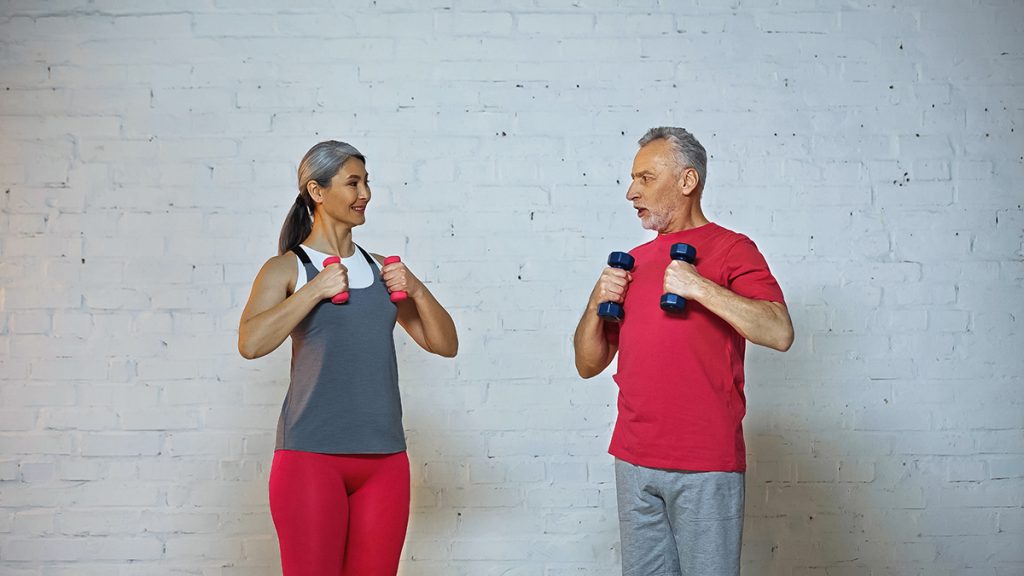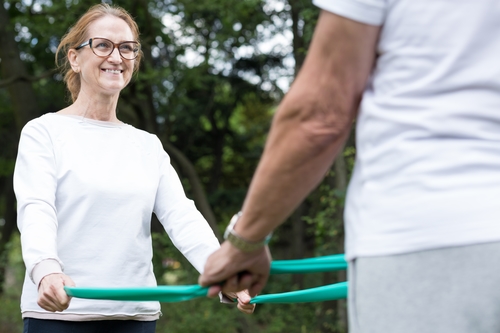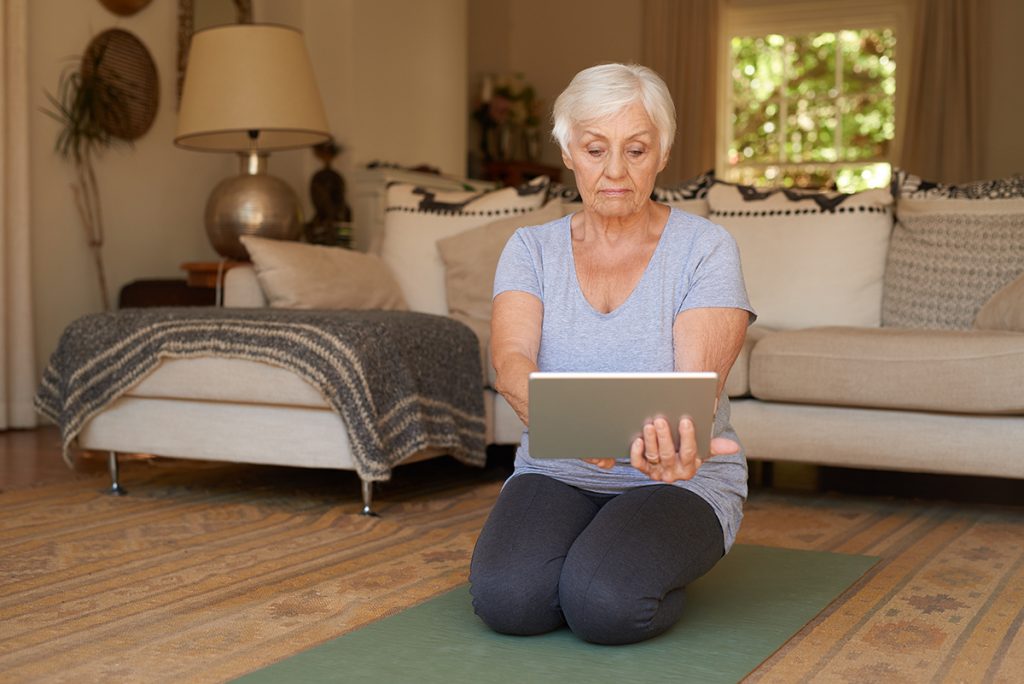Gene, a 77-year-old retiree, has been in quarantine for the previous 10 months. He was not comfortable leaving his house to go to the gym and has declined invitations to do virtual (online) training. Hence, Gene has lost significant muscle mass, has been prescribed increased quantities of medications for Type II diabetes and high blood pressure. Additionally, his wife reports she has seen his muscle mass, bone density and health rapidly decline. He has lost his appetite and his quality of sleep has also suffered. Gene was prescribed an anti-depressant by his primary care physician to address associated lethargy and depression.
 Joel, an 85-year-old male, has left his house a total of five times in the previous 10 months. Through his wife’s encouragement, he continued his at-home workouts and even increased the frequency of his sessions from two to three times per week once the quarantine moved beyond four weeks. During this time, Joel has increased his lean muscle mass, improved his balance and his wife reports his legs are ‘rock solid and his energy has never been better.’
Joel, an 85-year-old male, has left his house a total of five times in the previous 10 months. Through his wife’s encouragement, he continued his at-home workouts and even increased the frequency of his sessions from two to three times per week once the quarantine moved beyond four weeks. During this time, Joel has increased his lean muscle mass, improved his balance and his wife reports his legs are ‘rock solid and his energy has never been better.’
While Joel exemplifies the benefits of maintaining an active lifestyle and improving his muscle mass while in quarantine, he is in the minority. Unfortunately, there are millions of older adults just like Gene who are experiencing the deleterious impacts of quarantine and the sedentary lifestyle on their physical as well as emotional health. This is such a vital and overlooked aspect of health because many older adults may never fully recover in the event they contract a life-threatening disease.
This sentiment is summed up succinctly by (English and Paddon-Jones 2021):
“Thus, with advancing age, it becomes increasingly likely that even a brief, clinically mandated period of bed rest could initiate a serious decline in muscle strength and functional capacity, i.e., a “tipping point” from which some may not fully recover.”
This article will discuss how the Medical Fitness Professional (MFP) who focuses on educating and empowering their older clients can positively impact those experiencing sarcopenia-related health issues. Also included will be a brief discussion about the barriers to exercise suggestions the MFP can implement to address these issues. Finally, MFP’s will be empowered to utilize an education-first strategy while positioning themselves to attract more individuals that will seek out their expertise.
The Impact of Sarcopenia-Related Multisystem Deconditioning
Sarcopenia, or age-associated loss of muscle density and strength, is a major health problem even when not in a period of quarantine. The loss of muscle mass is associated with all-cause mortality including cardiovascular disease, diabetes, cognitive decline, depression and an increased risk of falls (Kirwan et. al. 2020). The average adult over 30 years of age experiences a 3-8% loss of muscle mass per decade (English and Paddon-Jones 2010). This means that a sedentary individual could literally experience between 9-24% loss of muscle strength and function by the time they reach 60 years of age. Furthermore, 71% of older American males and 42% of older American females present with moderate levels of sarcopenia.
Unfortunately, this problem is exacerbated by periods of forced inactivity, for example, while bedridden. Young adults can experience a 5-6% decrease in muscle strength per week when bedridden (English and Paddon-Jones 2010). Because older adults begin with less lean muscle tissue than their younger counterparts, they are extremely susceptible to multisystem deconditioning and the subsequent health issues associated with the loss of muscle, strength and endurance.
Sarcopenia is extremely concerning in vulnerable populations (example: older adults) as well as those with comorbidities (example: those with cancer). Muscle atrophy, weakness and pain (myalgia) is even greater after a significant illness and corresponding bedrest. It’s been reported that .5-6% losses in muscle mass per day can occur increasing risk of deteriorating health (Casey et. al. 2021). A 1.7% loss of muscle mass occurs in as little as 2 days and 5.5% after only 7 days of bed rest (Kirwan et. al. 2021). Additionally, 50% of patients experience ongoing myalgia and associated weakness which can last months after recovering from COVID-19 (Casey et. al. 2021). Additionally, the loss of smell, taste and appetite after illness leads to further losses in muscle mass as well as nutritional deficiencies potentially leading to further deterioration of one’s health.
The Sarcopenia Solution
While its etiology is multifactorial, decreased physical activity and poor nutrition are the two primary aspects contributing to the progressive loss of muscle mass in both the sedentary populations and those with chronic health issues (Kirwan et. al. 2020). Kirwan et. al. recommends that resistance exercise “…be considered of prime importance in attempting to halt and even reverse the progression sarcopenia.” Additionally, Web MD suggests that “The primary treatment for sarcopenia is exercise, specifically resistance training or strength training (downloaded from WebMD 2021).
While the strength and conditioning industry has long recognized and advocated the benefits of resistance training, getting individuals to comply with the recommended daily activity levels has been a challenge. The challenges to older adults remaining physically active have only been complicated by quarantine. Several organizations including the World Health Organization (WHO) have provided suggestions for getting the recommended 150-300 minutes of vigorous-intensity physical activity per week. To achieve this number while in quarantine, WHO Europe suggests taking short, active breaks, indoor walking and following an online exercise program.
Since quarantine has forced the closure of many commercial facilities and due to the fact that many older adults are reluctant to leave their house, online or virtual exercise programs have become increasingly popular. Online platforms including but not limited to Zoom, Google and Facebook make it easy to create small group meetings which provide a powerful tool for educating, providing guided exercise programming and increasing socialization, all of which are vital in combatting sarcopenia and isolation-related depression that occurs with prolonged quarantine.
 While historically it has been a barrier to exercising at home, novel equipment such as resistance bands make training at home both practical and functional. Resistance bands provide a low-cost option as compared to free weights (Kirwan et. al. 2021). While Sanchez-Sanchez et. al. (2019) found resistance bands did not provide as much benefit for older adults experiencing sarcopenia as compared to moderate to vigorous exercise, anecdotal finds report contrary findings. Progressive overload utilizing varying tensions of resistant bands and novel anchoring positions has been clinically shown to increase muscle mass, improve joint health and foster confidence in older adults when incorporated into an overall resistance training program (Osar and Linkul 2021).
While historically it has been a barrier to exercising at home, novel equipment such as resistance bands make training at home both practical and functional. Resistance bands provide a low-cost option as compared to free weights (Kirwan et. al. 2021). While Sanchez-Sanchez et. al. (2019) found resistance bands did not provide as much benefit for older adults experiencing sarcopenia as compared to moderate to vigorous exercise, anecdotal finds report contrary findings. Progressive overload utilizing varying tensions of resistant bands and novel anchoring positions has been clinically shown to increase muscle mass, improve joint health and foster confidence in older adults when incorporated into an overall resistance training program (Osar and Linkul 2021).
In addressing sarcopenia, the importance of nutrition cannot be overstated. High-quality protein (25-30 grams with each meal) to increase muscle mass is part of the lifestyle program recommended by English and Paddon-Jones (2010). Additionally, the consumption of nutrient-dense, calorie-sparse foods like roots, leaves, fruits and seeds can have a positive hormonal effect (Mattioli et. al. 2020) thereby improving mood and quality sleep, both of which are necessary to the overall health and vitality in older adults.
Solutions to the 3 Greatest Barriers to Resistance Training
Finally, while the benefits of resistance training for addressing sarcopenia are obvious, it would be remiss to leave this article without including a brief discussion covering a few of the barriers to older adults participating in physical activity. One of the greatest barriers for many adults participating in a physical activity program is the reluctance to be proactive about their health care. In part, this is because older adults haven’t been properly educated about the vital importance and their responsibility in self-care. Additionally, even when properly educated, older individuals are rarely given specific instructions and/or directions to achieving success.
Solution: In addition to the in-session education, the MFP looking to maintain their current clients and wanting to attract more individuals, should dedicate several hours per week to educating their community. Invite current and past clients to participate in a no-cost, regularly scheduled webinar, podcast or virtual training on a relevant health topic. Encourage them to invite their friends, family and colleagues. It is important that these events be education-based rather than focused on selling one’s services. Include at least one simple, actionable health nugget – a bodyweight exercise, mindset habit or healthy shake recipe, for example – that the participants can easily incorporate into their current lifestyle.
Another important barrier for older adults is the reluctance to seek out a fitness professional because the fitness industry has largely catered their offerings to younger, healthier individuals. This has discouraged countless numbers of individuals from exercising and made it increasingly challenging for the MFP to differentiate their services from the general personal trainer that is often ill-equipped in training the older adult.
Solution: The number one method for differentiating oneself and to enroll older adults is to highlight current client’s success. Highlighting a current client’s success eliminates the temptation to spend needless time discussing why one’s education is superior to someone else’s. For example, the MFP should highlight clients who can successfully garden or play with their grandchildren or hike because of the resistance training program they’ve been performing. Older individuals need to see, and will, in turn, be empowered by, seeing others just like them achieving success with physical activity programs. Seeing one their own age successfully accomplish things they would like to be participating in will help foster a natural curiosity. This curiosity can ultimately lead to a conversation where the MFP discusses how a tailored program can also help them accomplish their health and fitness goals.
Additionally, Fitness Professionals like Jackie Bachmeier (Evolution Fitness and Wellness) and Robert Linkul (Training the Older Adult), both of whom cater to training the older adult population, deliver the specific equipment (including resistance bands, hooks and self-myofascial release tools) they want their clients to utilize during their programs. This removes an additional obstacle while adding huge value to the client.
 The third major barrier to online training are technology-associated challenges. While many have legitimate technology challenges, the resourceful and proactive MFP can help remove that obstacle and ease older adults’ in their online transition.
The third major barrier to online training are technology-associated challenges. While many have legitimate technology challenges, the resourceful and proactive MFP can help remove that obstacle and ease older adults’ in their online transition.
Solution: Both Robert and Jackie have dedicated specific time to helping technology-challenged clients understand and develop the confidence in using social media and related platforms. While it may seem a hassle in the beginning, when they recognize the relative ease and benefits of online training, many older clients will enjoy the process and in turn encourage their family, friends and colleagues to join in. For example, Jackie’s 83-year-old client Lillian commented that had she realized how easy technology was, she would have done virtual training earlier. She’s since referred her husband and several of her friends to Jackie’s programs.
Conclusion
Sarcopenia is a rampant problem in older adults, complicating existing health issues and leaving this population particularly vulnerable to prolonged periods of inactivity. Exercise, particularly resistance training, and nutrition are two components that show strong evidence in improving muscle mass, improving health and reducing the risks of all-cause morbidity. By focusing older adults upon the factors within one’s control – i.e., physical activity, nutrition and mindset – the Medical Fitness Professional are well positioned to be the solution for both their current as well potential clients. By addressing the three major barriers to being physically active, the MFP can help their current clients regain their health and, in the process, differentiate themselves and attract more individuals that need, want and will pay for their expertise. By adopting these best-practices, the MFP can successfully position themselves as a major player in the solution to the sarcopenia dilemma.
Dr. Evan Osar is a Chiropractic Physician, an adjunct faculty member with Rocky Mountain University of Health Sciences (Motor Control) and educator with the Integrative Movement Institute. He has authored “Corrective Exercise Solutions to Common Hip and Shoulder Dysfunction” and Amazon #1 Best Seller, “The Psoas Solution“. He developed the Integrative Movement System™, an evidence-based approach to improving clinical outcomes and helping patients perform at their highest level. Dr. Osar is currently in private practice in Chicago, IL and educates health and fitness professionals that specialize in posture, corrective exercise and medical fitness for the older adult population.
References
Casey P, Ang Y, Sultan J. COVID-19-induced sarcopenia and physical deconditioning may require reassessment of surgical risk for patients with cancer. World J Surg Oncol. 2021 Jan 11;19(1):8. doi: 10.1186/s12957-020-02117-x. PMID: 33430881; PMCID: PMC7798369.
English, K. L., & Paddon-Jones, D. (2010). Protecting muscle mass and function in older adults during bed rest. Current opinion in clinical nutrition and metabolic care, 13(1), 34–39. https://doi.org/10.1097/MCO.0b013e328333aa66
Kirwan R, McCullough D, Butler T, Perez de Heredia F, Davies IG, Stewart C. Sarcopenia during COVID-19 lockdown restrictions: long-term health effects of short-term muscle loss. Geroscience. 2020 Dec;42(6):1547-1578. doi: 10.1007/s11357-020-00272-3. Epub 2020 Oct 1. PMID: 33001410; PMCID: PMC7528158.
Mattioli, A. V., Sciomer, S., Cocchi, C., Maffei, S., & Gallina, S. (2020). Quarantine during COVID-19 outbreak: Changes in diet and physical activity increase the risk of cardiovascular disease. Nutrition, metabolism, and cardiovascular diseases : NMCD, 30(9), 1409–1417. https://doi.org/10.1016/j.numecd.2020.05.020
Osar, E. and Linkul, R. (2021). The Arthritis Training Solution 2.0. Training the Older Adult Live (Virtual).
Sánchez-Sánchez, J. L., Mañas, A., García-García, F. J., Ara, I., Carnicero, J. A., Walter, S., & Rodríguez-Mañas, L. (2019). Sedentary behaviour, physical activity, and sarcopenia among older adults in the TSHA: isotemporal substitution model. Journal of cachexia, sarcopenia and muscle, 10(1), 188–198. https://doi.org/10.1002/jcsm.12369
Web MD. Sarcopenia with Aging. Downloaded 2/15/21 from https://www.webmd.com/healthy-aging/guide/sarcopenia-with-aging
World Health Organization. #healthy at home. Downloaded 2/15/21 from https://www.who.int/campaigns/connecting-the-world-to-combat-coronavirus/healthyathome?gclid=EAIaIQobChMItpfrsInt7gIV7vLjBx1pAwf0EAAYAyAAEgKgTfD_BwE
World Health Organization (Europe). Stay Physically Active During Self Quarantine. Downloaded 2/15/21 from https://www.euro.who.int/en/health-topics/health-emergencies/coronavirus-covid-19/publications-and-technical-guidance/noncommunicable-diseases/stay-physically-active-during-self-quarantine
